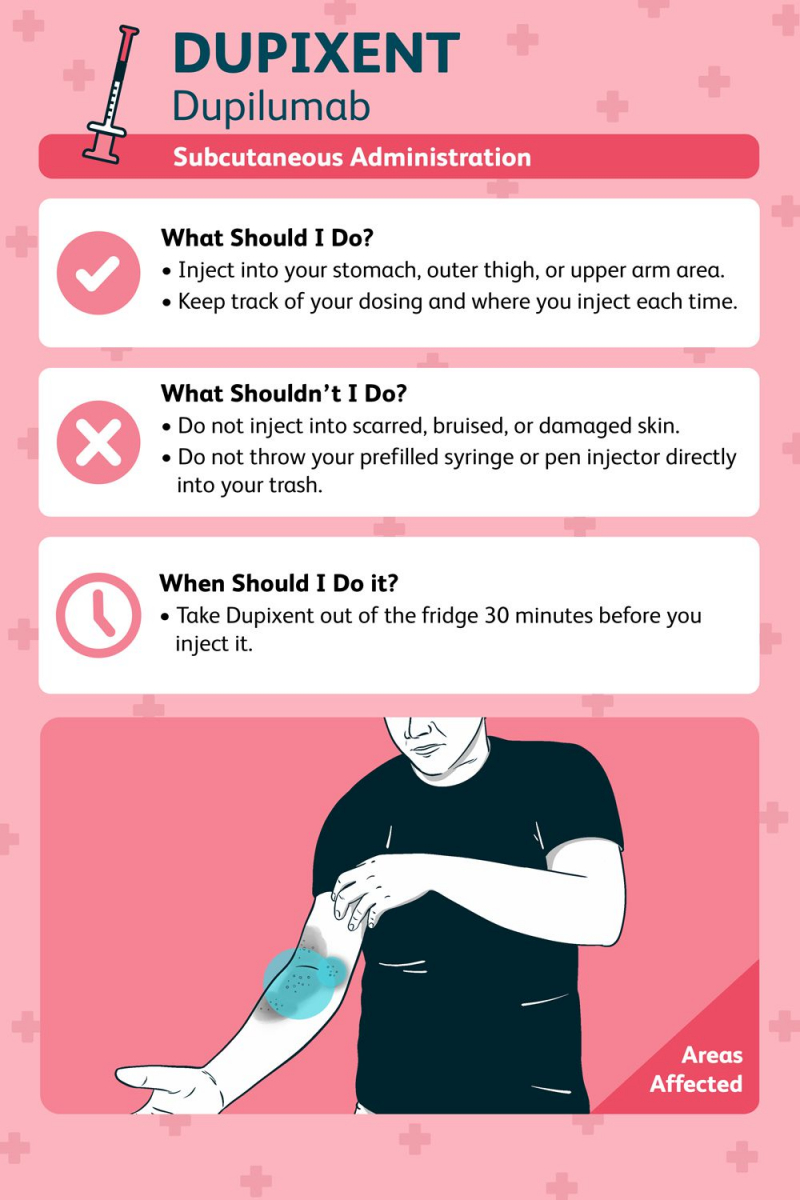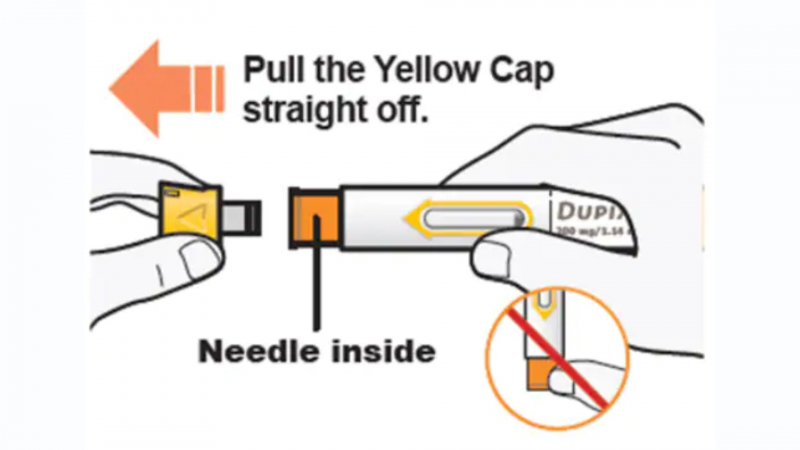Tips

Dupixent is available as a prefilled pen or a single-use prefilled syringe (with a needle shield). It is delivered as a subcutaneous (under the skin) injection and comes in a carton with two pens or syringes in each packet.
Ordinarily, Dupixent is given every other week (every second week).
Do not attempt to self-administer Dupixent until a healthcare professional has shown you how. Adults should supervise children aged 12 and up. Dupixent should be administered by an adult parent or caregiver to children under the age of 12. Except for the 2 inches (5 cm) around the belly button, the injection can be given into the thigh or stomach. If a caregiver injects the medication, the outer area of the upper arm can also be used. For each injection, select a different injection site. Dupixent should not be injected into skin that is tender, damaged, bruised, or scarred.
Use an alcohol wipe to clean the injection site. Before injecting, let your skin to dry. Get rid of the green cap. The pen should be held so you can view the window. At around a 90-degree angle from your skin, place the yellow needle cover there. The pre-filled pen should be pressed firmly against your skin until the yellow needle cover is hidden. When the injection begins, there will be a "click," and the window will begin to become yellow. Watch the window while continuing to push the pen against your skin. You'll see a total yellowing of the glass and a second "click." To ensure you receive the entire dose, keep pushing the pen against your skin while counting to five. Pull straight up after finishing your injection to remove the pen from the skin. The needle will be protected by the yellow needle cover. If there is any blood at the site, dab it lightly with a cotton ball or gauze pad. After the injection, do not rub your skin. Remove the pen and contact your healthcare provider if the window does not turn completely yellow. Do not take a second dose without first consulting with your healthcare provider. After using a pen, immediately place it in an FDA-approved sharps disposal container. Do not dispose of the pens in the trash.
Refrigerate unused Dupixent Pre-filled Pens between 36ºF and 46ºF (2ºC and 8ºC). Protect from light by storing in the original carton. Remove Dupixent from the refrigerator 30 to 45 minutes prior to injection and place it on a bench to warm up to room temperature. Dupixent can be stored at room temperature (77ºF [25ºC]) for up to 14 days if necessary. Shake, heat, freeze, or expose the pens to direct sunlight. Keep all medicines, including Dupixent Pre-filled Pens, out of the reach of children.
Side effects of Dupixent include injection site reactions, eye problems (such as conjunctivitis or eye inflammation), and cold sores on the lips and mouth (oral herpes); however, most of these side effects can be effectively managed with other treatments, such as eye drops or anti-virals, allowing people to continue using Dupixent, especially if it provides significant benefits.
Conjunctivitis, blepharitis, dry eyes, itchy eyes, and keratitis are all associated with this condition. The reason for this is that Dupixent works by inhibiting two inflammatory proteins, IL-4 and IL-13. IL-13 also stimulates goblet cells, which are responsible for producing mucus in the eye and ensuring the stability of tears. So, when Dupixent inhibits IL-13, it reduces the number of epithelial goblet cells, resulting in inflammation and eye problems. Most of the time, the inflammation is mild, but Dupixent may need to be discontinued in some patients. The majority of eye problems respond to standard treatments (eg, ophthalmic antibiotics for bacterial conjunctivitis).
If you feel facial or throat stiffness after taking Dupixent, please seek immediate medical treatment. If you develop any additional side effects, such as eye issues, herpes infections, or weight gain, let your doctor know.
Inform other medical providers that Dupixent is being administered to you. You should have had all necessary vaccines before beginning Dupixent. You should avoid obtaining any live vaccines while using Dupixent (such as the MMR vaccine or the chickenpox vaccine).
Although it is unknown how Dupixent affects a developing infant, your doctor may still recommend using it if the advantages outweigh the dangers. If you become pregnant while taking Dupixent, tell your doctor right away.








